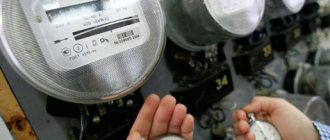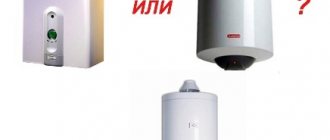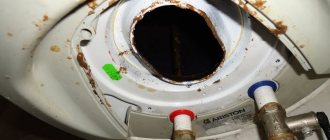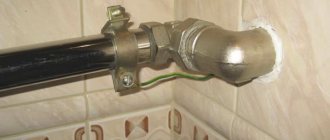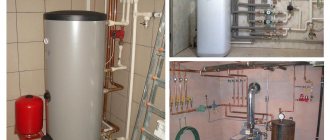The question of whether it is possible to keep the boiler constantly connected to the network interests many. What is more profitable - to heat the water constantly or to turn it on only when you need to wash? How to solve this issue correctly?
An electric water heater with a large storage tank is a very useful purchase for the home. Especially if there is no other source of hot water. Both the owner of a private house and a resident of a high-rise building, where hot water outages are frequent, can appreciate it.
But which mode of operation is the most economical and safe? At first glance, everything is elementary: hot water is required - turn on the boiler; if it is not required, do not turn it on. But this is only at first glance; upon closer examination, everything is not so simple.
Is it safer to turn off the boiler or keep it constantly running?
Modern electric water heaters are equally safe in any mode, both during continuous operation and when periodically plugged into the network. A normal, working boiler has several protection systems - a thermostat (often there are several), a non-return safety valve, and grounding to protect against electric shock.
Of course, if you plan to leave for several days, then the boiler needs to be unplugged. Like all other electrical appliances.
And a separate question - how do you turn off the boiler from the network? Do you pull the plug from the socket or turn it off with a button? If you constantly pull out the plug, this is dangerous, as it quickly leads to sparking of the socket and its destruction, which can lead to a fire due to faulty electrical wiring.
Do I need to turn off the water heater?
Can turning off equipment at night save the family budget? Only if the tank is large.
Example. A family of 3 uses a boiler with a capacity of 120 liters. After taking a shower and washing dishes, they leave the device for 4-5 hours to heat up, after which they turn it off at night. This approach allows you to save 10-15% on electricity.
It is important to consider in which room the device is located. If the room is heated, heat loss will be minimal - about 7 degrees in 12 hours. Manufacturers minimized heat loss by using polyurethane foam and other materials to insulate the housing.
How often can I turn off the device? Constantly if you really want to reduce costs. Every night you will have to turn off the boiler to save a few kilowatts.
Is this justified? As we already wrote, only with large capacity. If you set a low temperature, then there is no point in interfering with the operation of the equipment. Not much energy is spent on heating the liquid.
Water Heater Basics
The entire boiler operation process consists of three stages:
- Filling the boiler with water from a cold main.
- Heating this water to the temperature you set,
- Distribution of already heated water for the intended purposes.
When the boiler is turned off, you need to restore the normal water supply from the taps
How to fill the boiler and turn it on
The sequence of actions required to get started is simple.
- We turn off the general hot water supply tap from the main supply system. This will prevent heated water from flowing back into the main pipe from the device.
Before using the boiler, you must turn off the hot water tap on the riser - Open the hot water valves in the kitchen and bathroom, draining the remaining water in the system.
- Then we fully open the taps that supply hot and cold water to the boiler. Fill the tank and turn off the water.
- We connect the boiler to the outlet (the indicator light must light up). Using the thermostat switch, we set the heating program we need. We put the device into operation.
- By turning the thermostat, we will be able to regulate the water temperature from the minimum to the maximum marked on the thermostat handle. When the set heating indicator appears on the thermostat, the device will signal with the indicator light on.
Using a thermostat, we achieve heating of water to the desired temperature - Just in case, we inspect the pipes for leaks. Now you can use hot water at your discretion.
When you start the device in heating mode, make sure that it is filled with water as much as possible. Turning on an empty boiler in this mode will lead to its immediate breakdown.
If the water in your region is “hard” (with a high salt content), it is recommended to install a magnetic softener at the inlet of the boiler or install a filter. They slow down the corrosion process and increase the service life of the device.
How to turn off a water heater
To turn off the boiler, you need to do in reverse order all the steps performed when you turned it on. That is, return the normal flow of water from the central pipeline to the mixers.
- We stop the heating program performed by the device. Disconnect it from the network.
- Close both water taps (cold and hot) going to the boiler.
- We leave the water heater in this position until the need to use it again arises.
- Open the hot water tap coming from the main pipe of the system.
While the heater is in operating mode, do not under any circumstances disconnect it from the power supply.
It is not advisable to turn the water heater on and off very often. This can lead to failure of the entire automation of the device. If you heat water daily, it is better not to turn off the boiler at all. Disabling it completely is recommended only in case of prolonged non-use.
Video: turning the boiler on and off by time
How to set up a boiler
The more we heat the water in the boiler tank, the more water we get at the temperature we need when mixed with cold water. If the need for hot water is small and you have water meters installed, then it will be convenient to set a temperature regime that allows you not to dilute the water at all. This way we will save both water and electricity.
The recommended optimal water temperature is 55 °C. At this degree of heating, the rate of scale deposition is lowest. Temperatures below 55 °C also do not always have a good effect on the device. For example, water at 30–40 °C is an ideal environment for the growth of bacteria, leading to fungal infections of the tank walls. In such cases, the water acquires a hard-to-remove moldy smell.
What is more profitable - turn off the boiler or let it run constantly?
If the boiler is modern, then we can say unequivocally that turning it off will not provide any significant savings. Well, unless you're going on vacation for a week.
The fact is that almost all electricity consumption is associated with heating new cold water. For example, if you have used 20 liters of hot water, 20 liters of new cold water will immediately flow into the boiler. It is precisely to heat this water that electricity is consumed.
As for the standby mode, when the boiler simply maintains the temperature of already heated water, modern water heaters have fairly good thermal insulation. They hold the temperature many times better than thermoses. Therefore, apart from additional worries, turning the boiler on and off will not give anything else.
If no one uses hot water at night, the temperature sensor is triggered only a few times during the night, the heating is turned on for a short time, and little electricity is used for heating. But in the morning there is hot water.
If you turn off the boiler at night, then in the morning there will be a large energy consumption - all the water that has cooled down overnight will have to be heated. Even if you only need a quick shower in the morning.
How does an electric boiler work?
A storage water heater, or boiler (from the English boiler) is a large container filled with water. It is heated using a heating element placed inside it.
A modern water heater, connected to the electrical network and water supply, operates automatically. It has a special regulator with which the required water temperature is set. When the water in the tank is cold, the heating element turns on and heats the water, consuming electricity. As soon as the water has heated up to the set temperature, the sensor is triggered and the heating element is turned off. Hot water from the tank is gradually used for some needs and instead cold water from the water supply is added to the tank. As soon as the temperature drops, the sensor is triggered and the heating element is turned on for heating again.
What happens if hot water is not used? Nothing happens. It is still stored in the tank. The storage tank of the boiler is something similar to a thermos. It has several layers of insulation and retains heat very well. Of course, over time the temperature drops and then the heater turns on again briefly and heats the water to the required temperature.
When heating a large amount of cold water, a lot of electricity is spent; when heating water by 2-3 degrees, the heating element turns on for a few minutes, and very little electricity is spent. Many people have a question: does it make sense to disconnect the boiler from the network? What is more profitable - keeping the water heater on all the time or turning it on only when hot water is needed?
To answer this question, you need to consider 3 sides of the question:
- Safety;
- Convenience;
- Which mode is more economically profitable?
How to turn off the boiler: instructions
When there is no longer a need to use the boiler, it has to be turned off. To do this, you need to disconnect the device from the power supply. The further scheme for turning off the heater depends on whether it is dismantled or remains in its original place.
Water heater diagram
Disabling for a while
The first thing to do in this case is to pull the wire out of the outlet. Before doing this, be sure to set the regulator located on the instrument panel to the “Off” position. Sometimes it is necessary to disconnect the boiler from the meter. Next, close the taps in the following order:
- First, turn off the cold water tap so that it does not fill the tank.
- Open the hot water tap on the riser. After the flow of water stops, you need to check whether there is any remaining in the tank. Otherwise, you need to wait until it cools down or drain it immediately.
After these manipulations, you need to check whether there is water in the tank. This can be checked by blowing into the hose. If you hear a murmur, unscrew the fuse and open the outlet valve of the electric heater and completely drain the water.
If the heating element has a more complex design, then you cannot do without the help of a specialist. Typically, in this case, the pipes are connected to heated towel rails and other devices. They can be part of an underfloor heating system. Also, possible problems due to failed faucets, plaque deposits on the internal surfaces of faucets, and so on cannot be ruled out, which can become a serious obstacle to disconnecting the boiler from the water supply.
Before disconnecting the boiler from the network, you must turn it off
Disconnection with dismantling
To turn off the heater and then dismantle it, you will need the following tools:
- wrench;
- pliers;
- basin/bucket for draining water from the heating element.
Before removing the device, you must turn it off and remove all water from the tank. To do this, place a container under the heater to drain the liquid, unscrew the valve, and remove the hose from the tap supplying cold water. In its place, a rubber hose is put on, the end of which is lowered into a container.
After you have drained the water from the heater, you need to disconnect the thermostat and the electrical part of the device. Then open the boiler lid and remove any remaining water. It is important to clean the inner surface of the tank and remove scale from curved sections of pipes.
For economy and middle class devices, the design may differ slightly. Thus, for heating elements of the middle price category, the flanges are attached mainly to the neck of the heater using 6 bolted connections. However, this does not change the algorithm for dismantling the boiler. But when disassembling a flat heater, you need to take into account some features of the process. After disconnecting the device from the electrical network and draining the water, you must perform the following steps:
- unscrew the plug;
- remove plastic shields;
- remove the screw located in the center of the boiler cover;
- to remove electronic components, remove the bottom cover (at this stage it is best to capture the “filling” in a photo in order to later return all the elements to their places);
- disconnect the control and thermal control chip, remove the connectors coming from the external control board.
Thus, disassembling a plate water heater is more complex and requires special training. In this case, it is best to seek qualified help.
Before disassembling the heating element, you should remember its diagram
How to reduce your electricity consumption
It is not necessary to deal with constant shutdowns; it is better to do the right thing from the beginning.
Optimal installation location
Consider the distance of the boiler from the point of collection. The additional length of the pipes “steals” heat. Imagine: you open the faucet, hot water comes out of the tank and pushes cold water in front of it. For every meter of pipe (1/2″) you lose 0.2 liters of boiling water. When you close the mixer, you lose the same amount of hot liquid. Hot water remains in the pipes and cools down.
Optimize heat loss by placing the device closer to the kitchen sink, taking into account the distance of the intake point in the bathroom.
Of course, remember to use common sense when installing. If your most advantageous installation point is in the corridor, then choose a place where operation will be convenient for all family members.
If you want to save money, insulate pipes and fittings. Put polypropylene covers on them.
